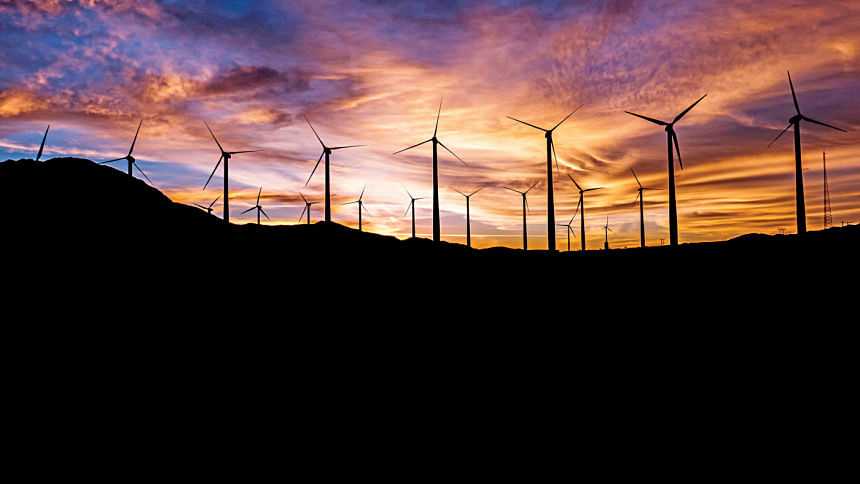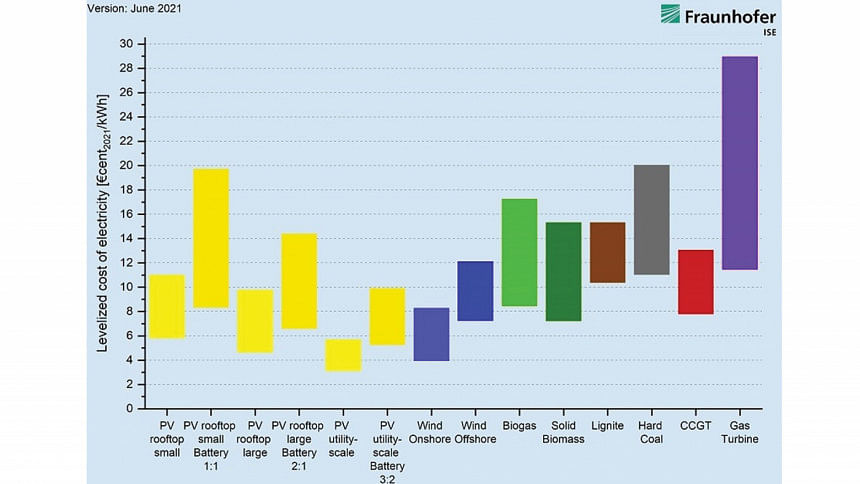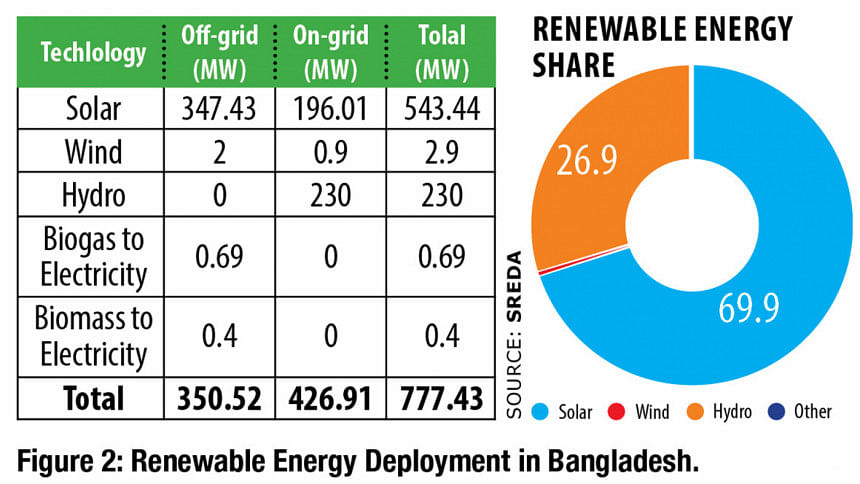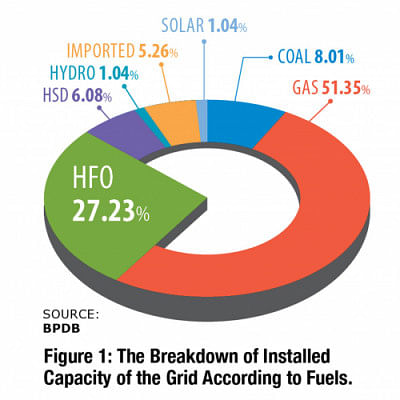The future of renewable energy in Bangladesh

Renewable energy (RE) comprises of energy from the sun (directly), usually called solar, biomass, wind, tidal, geothermal and hydro. The endowment of these resources will determine how much of each form of renewable energy source can be exploited in a country. For example, Bangladesh does not have geothermal potential and its hydro potential, especially that based on elevation, is small. Tidal is a new form of energy source that is yet to achieve commercialisation. It thus leaves solar, wind and biomass as the only current options. With regards to biomass, the principal problem is the high demand of agricultural and animal wastes for cooking in rural areas. Moreover, extracting too much organic matter in an unsustainable manner can lead to soil degradation. However, through the bio-gasification route, there exists significant potential, but that would require careful planning and management of the bioresources.
In the case of Bangladesh, the principal barriers with biomass are; the price is high and collecting large quantities is difficult, hence expensive. Wind has always been a problematic resource to evaluate in the context of Bangladesh. A group of experts believe that the wind potential in Bangladesh, especially onshore, is limited. The offshore potential is unknown, even though one does hear of unsubstantiated claims of huge potential. In financial terms, it is difficult to comment on this in the absence of comprehensive environmental and technical investment grade studies on offshore wind potential.
Solar energy is the single most dependable RE resource that can be resourced on a large scale. This expectation is turning out to be true with local and foreign investments occurring in grid-tied utility scale solar parks and industrial rooftop projects. According to the Chairman of SREDA, more than 1,000 MW of utility scale solar parks and 500 MW of commercial/industrial rooftop solar PV projects under the net metering scheme are on the horizon.

According to the Bangladesh Power Development Board (BPDB), as of January 2022, Bangladesh had 22,066 MW of grid-connected installed capacity, the fuel wise breakdown of which is shown in Figure 1. RE consists of only 2.08 percent of the total installed capacity connected to the grid; half of that, i.e., 1.04 percent is hydropower, which has remained static in generation since 1967. The complete picture of RE deployment can be seen from Figure 2, which shows both on-grid and off-grid RE applications. A large portion of the claimed 543 MW solar power is off-grid solar, grid-tied solar parks only contributes 196 MW. It is worth pointing out that, as a result of the extension of rural electrification through the expansion of the grid, a large portion of the Solar PV Home Systems that brought so much fame to Bangladesh is lying idle. As expected, RE in Bangladesh is dominated by solar with other sources being very small in comparison.
It is clear that Bangladesh is struggling to increase the share of RE in its energy mix. The future of RE in Bangladesh also does not look very bright, unless the government takes steps to explore new and innovative ways of harnessing RE.
Agricultural land and solar projects
The single biggest barrier to the large-scale deployment of solar PV electricity is the acute shortage of land. The problem is more connected with the policy—total ban on use of agricultural land for solar projects—than land availability. In Bangladesh, land is very fragmented, and it is very difficult to find contiguous land to construct even a 50 MW solar park without encroaching onto agricultural land. Thus, instead of a total ban, a policy could be formulated that permits a certain amount of agricultural land; say 25 percent of the land of a single solar park, to a maximum of 200 acres per project.
The use of only one percent of the total agricultural land of Bangladesh can facilitate the construction of approximately 50,000 MW of solar power plants. Using the average capacity factor of 4.5 hours per day for Bangladesh, the electricity output from the one percent agricultural land is approximately 82,000 GWh, which is more than the total consumption in the year 2020. If the cost of fuel saved is compared with the output of even three-cropped land, the financial benefits will be more than five times. The lost agricultural output of the one percent land can be easily made up by preventing spoilage that occurs due to the lack of cold storages and other processing facilities.

Optimal dual usage of land and Floating Solar Farms ('floatovoltaics')
Since land is very expensive in Bangladesh, dual use of land can make many solar projects viable. There are over 2.83 million hectares of low-lying land in Bangladesh (roughly 20 percent of the total area of the country). Using such low-lying land combined with fisheries is one such innovative solution. A 50 MW solar-fisheries project has been approved and project implementation is underway.
"Floatovoltaics" are photovoltaic (PV) solar power systems designed for floating on reservoirs, lakes, rivers, and other water bodies. Floating solar farms can generate huge amounts of electricity without using valuable land. Bangladesh, being a riverine country, is ideal for floatovoltaics deployment. A comprehensive study and pilot projects are required to harness this potential. Numerous lakes and reservoirs are under the jurisdiction of WASA can be developed as private-public joint venture projects.
There are many other innovative solar technologies being researched and commercially developed. One very promising technology for Bangladesh is "Agrivoltaics", where crops can be grown beneath the solar panels. A standard conventional solar panel is largely opaque to sunlight. Therefore, underneath the PV panels most crops will not grow. Panels require only a small portion of the solar bandwidth; therefore, technologies are being developed that can filter this for electricity production and pass through the infrared and ultraviolet rays needed by plants, i.e., a translucent/transparent solar panel. If this technology achieves full commercial application, the land constraint that Bangladesh is facing will be removed.
Electricity transmission network
Despite the fact that Bangladesh is a small country in terms of area; electricity grid coverage is very poor. Inexpensive land is invariably located far from the existing electricity infrastructure. The Bangladesh government needs to undertake a massive grid modernisation initiative. The carrying capacity of the national network of transmission lines needs to be made smart and expanded throughout the country. Being geographically small, no matter where the solar plant is located the grid should be able to deliver power anywhere in the country with minimal losses. With a smart, integrated transmission network connected regionally, the intermittent nature of renewable energy can be made more reliable and robust.

Solar combined with Battery Energy Storage System (BESS)
Solar PV electricity is already the cheapest source of electricity in many places, but it is only available when the sun is shining. To make solar PV electricity available at other times and make it a source that can truly replace fossil fuels, one has to store the electricity for later use. At the present time, the most promising technology is battery. BESS is one of several technology options that can enhance power system flexibility, reliability, and enable high levels of renewable energy integration. Due to technological innovations and improved manufacturing capacity, lithium-ion chemistries have experienced a steep price decline of over 70 percent from 2010-2016, and prices are projected to decline further.
Technological advancements and cost reduction
Fraunhofer Institute for Solar Energy Systems ISE has presented the newest edition of their study on the levelized cost of electricity (LCOE) of renewable power plants as shown. Even though the information contained is applicable for Germany, where wind and solar are very cheap and coal is expensive because of a carbon tax, it nevertheless provides good indications of how renewables especially solar PV is gaining in cost advantage against conventional fuel-based electricity.
In Germany, the cost of electricity from Combined Cycle Gas Turbine (CCGT), the technology of choice in Bangladesh, is more than electricity from PV Utility Scale Battery. The average cost electricity from PV Utility Scale Battery in Bangladesh would be around Tk 15, which is nearly 100 percent more than in Germany, while electricity from LNG based CCGT would be approximately Tk 10.

At the present time, therefore, PV Utility Scale Battery is much more expensive than one of the cheaper electricity options for Bangladesh, but this 100 percent cost difference is expected to disappear by 2030, making solar electricity comparable in cost to any conventional electricity. Therefore, it is important to revise the country's Power System Master Plan (PSMP) and integrate solar options in a meaningful way by taking into consideration the fast-changing reality of utility scale solar power plants with storage.
The country experiences peak power demand on average 3 hours a day, i.e., from 7 PM to 10 PM. A BESS project may be designed such that during daytime when the sun shines it charges a battery pack and discharges the stored power at that time. That, this is a financially viable solution, can be verified from Figure 3; the cost of electricity for PV Battery is much lower than Gas Turbine. Therefore, the peaking Gas Turbine power plants (assuming those to be fired by LNG) and the oil-based (HFO and diesel) power plants can immediately be retired in favour of PV Battery power plants.
Administrative measures and regulatory reforms
Bangladesh has announced bold plans around renewable energy adoption in COP26. The Nationally Determined Contribution (NDC) talks about a target of 4,100 MW Renewable Energy by 2030. However, these plans would be hard to mobilise from a private sector perspective unless substantive changes to the grid and regulatory reforms are implemented. Numerous obstacles for RE companies in the private sector are hampering the widespread use of renewable energy. Some of the major challenges are enumerated below:
1. Lack of strategic direction: The RE sector in Bangladesh lacks a clear strategic direction in terms of setting targets from specific technologies. Shifting government priorities have seen some technologies (Solar Home Systems, Mini-grid) being hamstrung.Different competing energy sources and power systems are also shifting the government's focus from RE. Fuel Oil-based Quick Rental Power Plants from small independent power producers are still a major and costly portion of the power mix, and these need to be gradually phased out to make room for RE.
2. Failure of the early unsolicited utility-scale solar projects: The major points of contention were land availability and land acquisition, securing the Right of Way (ROW), and challenges surrounding grid-interconnection.
3. Lack of proper studies, bankable data, regulatory checklist in the wind energy sector: The private sector is exposed to a lot of risk in terms of acquiring reliable and authenticated data. There is a dearth of data in terms of land availability, substation load capacity, site specific data, etc.
4. Investor/lender interest surrounding uncertainties: Foreign investors/lenders are deterred over project timelines, interagency navigation, contract lock-ins (e.g., a local partner and their foreign partner need to be a part of the project for at least 6 years), and lack of clarity over various regulations.
5. Utility distribution companies' upgradation: The distribution utilities in its current state are inadequate to support mass RE adoption to serve the local electricity market.
The underlying problems are two-fold, first, in the infrastructure readiness and planning level, and second, in terms of capacity and preparedness of many local level offices.
Ijaz Hossain is professor (Retired), Chemical Engineering Department, BUET.
Ishtiaq A Chisti is P.E., Energy Consultant.

 For all latest news, follow The Daily Star's Google News channel.
For all latest news, follow The Daily Star's Google News channel. 



Comments